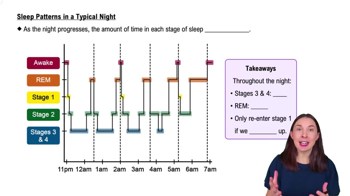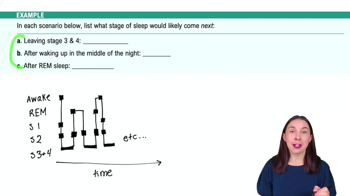Table of contents
- 1. Introduction to Psychology1h 43m
- 2. Psychology Research2h 20m
- 3. Biological Psychology2h 41m
- 4. Sensation and Perception28m
- 5. Consciousness and Sleep32m
- 6. Learning41m
- 7. Memory34m
- 8. Cognition37m
- 9. Emotion and Motivation35m
- 10. Developmental Psychology33m
- 11. Personality48m
- 12. Social Psychology41m
- 13. Stress and Health41m
- 14. Psychological Disorders44m
- 15. Treatment47m
5. Consciousness and Sleep
Sleep
Struggling with Psychology?
Join thousands of students who trust us to help them ace their exams!Watch the first videoMultiple Choice
Night terrors are experienced
A
during deep non-REM sleep.
B
during REM sleep.
C
during N1 (R&K Stage 1).
D
most often during a microsleep.
 Verified step by step guidance
Verified step by step guidance1
Understand the different stages of sleep: Sleep is divided into REM (Rapid Eye Movement) and non-REM stages. Non-REM sleep is further divided into stages N1, N2, and N3.
Identify the characteristics of each sleep stage: REM sleep is associated with vivid dreams, while non-REM sleep, particularly stage N3, is known as deep sleep and is characterized by slow-wave activity.
Learn about night terrors: Night terrors are a type of parasomnia, which are disruptive sleep disorders that occur during arousals from non-REM sleep, typically during the first third of the night.
Determine when night terrors occur: Night terrors usually happen during deep non-REM sleep, specifically during stage N3, which is the deepest stage of non-REM sleep.
Eliminate incorrect options: Since night terrors occur during deep non-REM sleep, they do not occur during REM sleep, N1 stage, or microsleeps, which are brief episodes of sleep lasting only a few seconds.

 3:25m
3:25mWatch next
Master Circadian Rhythms with a bite sized video explanation from Hannah Gordils
Start learningRelated Videos
Related Practice


































































































![Race, Genes and IQ Differences | Bret Weinstein [Mini Clip]](https://img.youtube.com/vi/IztL_m3pd70/mqdefault.jpg)



































































































